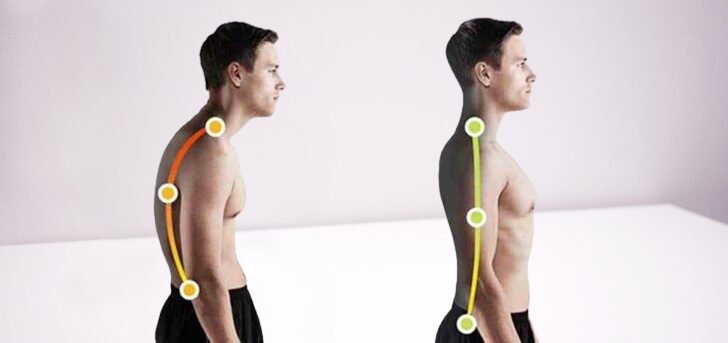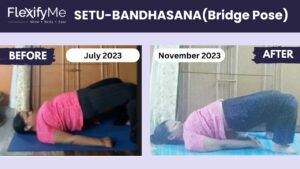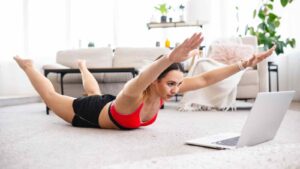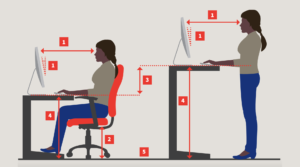Introduction to Spinal Health and Posture
Imagine this: you’re walking down the street, head held high, shoulders relaxed, and a confident stride in your step. People might even subconsciously perceive you as more approachable or successful. That’s the power of good posture!

But beyond the outward appearance, good posture is the foundation for a healthy and pain-free life. It’s not just about aesthetics; it’s about how your body functions from the inside out.
The Body’s Unsung Hero: Your Spine and Posture
Think of your spine as the central tower of a magnificent castle. It provides the core structure, supports your entire body weight, and allows for flexible movement. However, just like a castle with a crumbling foundation, a misaligned spine can lead to a cascade of problems.
Here’s the food for thought for you: maintaining good posture isn’t just about avoiding backaches (although that’s a pretty big perk!). According to the National Institute of Arthritis and Musculoskeletal and Skin Diseases, poor posture can lead to:
- Chronic pain: Constant muscle strain and imbalances can morph into chronic pain in your back, neck, and shoulders.
- Reduced mobility: Over time, a hunched posture can tighten muscles and limit your range of motion, making simple activities like bending down or reaching for something overhead feel like a struggle.
- Breathing difficulties: When your posture is compromised, your lungs have less space to fully expand, potentially leading to shortness of breath and decreased energy levels.
The Mind-Body Connection: How Posture Affects Your Mood
Good posture isn’t just about physical benefits. Studies have shown a surprising link between posture and mental well-being. Standing tall and holding your head high can actually boost your mood and confidence! It makes sense – when you feel strong and supported physically, you’re more likely to project that confidence outwards.
Unlocking Your Best Posture: Your Journey Starts Here
Ready to ditch the aches, pains, and hunched shoulders? This blog post is your roadmap to a healthier, happier you! In the following sections, we’ll delve into the world of yoga and explore how it can be a powerful tool for improving your posture and alleviating back pain. We’ll also provide targeted yoga poses for common postural issues, along with modifications for different fitness levels.
Understanding Common Postural Issues
Ever wonder why your friend seems to hunch over constantly, while your co-worker always walks with a ramrod-straight back? The answer might lie in their posture. Good posture isn’t just about looking good in that new outfit; it’s about how your body aligns itself throughout the day. But what happens when that alignment goes awry? Let’s delve into three common postural issues and how they can impact your well-being.
1. Kyphosis: The Rounded Back Blues
Imagine a hunchback from an old movie. That exaggerated curvature of the upper back is a classic sign of kyphosis (pronounced kif-OH-sis). While some rounding in the upper back is normal, excessive kyphosis can lead to pain, stiffness, and even breathing difficulties.

Kyphosis isn’t just an aesthetic concern. According to the University of California, San Francisco , it can also:
- Strain your neck and shoulders: The extra curvature in your upper back throws your entire spine out of whack, putting undue stress on your neck and shoulder muscles.
- Lead to digestive issues: A hunched posture can compress your internal organs, potentially causing heartburn, indigestion, and constipation.
- Affect your mood: Studies suggest a link between poor posture and feelings of depression and low self-esteem.
2. Lordosis: The Excessive Sway Back
Ever seen someone with an exaggerated arch in their lower back? That’s lordosis, and while a slight curve is natural, an excessive sway can cause problems.
Here’s the catch: Lordosis often co-exists with other postural issues like weak core muscles and tight hamstrings. If you suspect lordosis might be affecting you, a visit to a healthcare professional can help determine the cause and recommend appropriate treatment strategies.
3. Rounded Shoulders: Slouching Your Way to Pain
Do your shoulders seem to perpetually droop forward? This is a common posture issue often caused by tight chest muscles and weak upper back muscles. Rounded shoulders can not only make you look slumped but can also contribute to neck pain, headaches, and even rotator cuff problems.

Spotting the Signs: A DIY Posture Check
While a healthcare professional can provide a more thorough assessment, here’s a simple DIY posture check you can try at home:
Stand with your back against a wall, heels flat on the floor. Ideally, a small gap should exist between your lower back and the wall. Now, slide your hand down your back – can you comfortably fit your fingers in the space between your spine and the wall? If not, it might be a sign of excessive curvature.
Remember, this is just a basic check. Consulting a doctor or physical therapist can provide a more personalized evaluation and treatment plan.
- Include a side-by-side image comparison of normal spine curvature vs. kyphosis.
- Include an image of someone with lordosis for illustration purposes.
- Include an image highlighting rounded shoulders.
By understanding these common postural issues and their potential consequences, you can take steps to improve your posture and reap the benefits of a healthy, aligned spine.
Yoga for a Healthy Spine: Building a Strong Foundation
Imagine this: you gracefully flow through yoga poses, your spine feeling strong and supported. Yoga can be a game-changer for spinal health, but before diving into advanced postures, let’s explore some foundational principles to maximize your practice’s benefits.
The Pillars of Spinal Health in Yoga: Core and Breath
- Core Strength: Think of your core muscles as your body’s natural girdle. They act as a support system for your spine, helping you maintain proper posture throughout the day. Many yoga poses target and strengthen these core muscles, promoting spinal alignment and preventing pain.
- Breathwork (Pranayama): In yoga, proper breathing isn’t just about supplying oxygen to your muscles. Deep, diaphragmatic breaths help activate your core muscles and stabilize your spine. Focusing on your breath during yoga poses can not only improve your posture but also promote relaxation and stress reduction.
Safety First: Warming Up and Listening to Your Body
Just like any physical activity, yoga requires a proper warm-up to prepare your body for movement. Gentle neck rolls, shoulder circles, and spinal twists can increase blood flow to your muscles and loosen up your joints, minimizing the risk of injury.
It’s crucial to listen to your body’s limitations. Yoga is a journey of self-discovery, not a competition. If you experience any discomfort during a pose, ease off or come out of it completely. Pushing yourself into pain can hinder your progress and even lead to injury.
Building Your Practice: A Gradual Approach
Don’t be intimidated by the seemingly complex yoga poses you see online. It’s best to start with basic postures that focus on proper alignment. As you gain strength and flexibility, you can gradually progress to more challenging exercises. There are many online resources and yoga studios offering beginner-friendly classes to help you build a safe and effective practice tailored to your individual needs.
The benefits of yoga extend far beyond spinal health. Consistent practice can improve your flexibility, reduce stress and anxiety, and even boost your mood. By incorporating these foundational principles, you can transform your yoga practice into a powerful tool for building a strong, healthy, and pain-free spine.
Countering Kyphosis with Targeted Yoga Poses
Ever feel a hunch creeping up on you? Kyphosis, a rounding of the upper back, can affect posture and cause discomfort. But fear not, yoga offers a gentle and effective way to combat this rounded hunch. Here’s how specific yoga poses can help:
Many people have found success in managing kyphosis through yoga. Sarah, a yoga enthusiast for over 10 years, shares, “After incorporating these poses into my routine, I noticed a significant improvement in my posture. I don’t hunch as much anymore, and the nagging pain in my upper back has subsided.”
Let’s delve into some beneficial yoga poses for kyphosis, but remember, consulting a healthcare professional before starting any new exercise program is always recommended.
1. Cobra Pose (Bhujangasana):
- How to: Lie on your stomach with your palms flat on the floor beside your shoulders. Press your forearms into the mat as you lift your upper chest and head off the ground. Keep your hips grounded and gaze slightly upwards.
- Benefits: This gentle backbend opens the chest, stretches the shoulders, and strengthens the spine muscles that support proper posture.
2. Locust Pose (Salabhasana):
- How to: Lie on your stomach with your legs extended behind you. Engage your core and lift your chest, head, and legs off the ground. Hold for a few breaths.
- Benefits: This pose strengthens the back extensor muscles, which help pull your shoulders back and improve kyphosis-related rounding.
3. Bridge Pose (Setu Bandhasana):
- How to: Lie on your back with your knees bent and feet flat on the floor. Lift your hips off the ground, keeping your shoulders grounded. Interlace your fingers beneath your body for added support.
- Benefits: Bridge pose stretches and strengthens the chest muscles, counteracting the excessive rounding associated with kyphosis. It also strengthens the core and glutes, promoting overall spinal stability.
4. Supported Backbends:
For those with more advanced practice, supported backbends using yoga props like bolsters or blankets can be highly beneficial. These poses gently open the chest and stretch the front of the body, creating a counterbalance to the rounded upper back.
Remember:
- Listen to your body: Don’t push yourself into pain. If you experience any discomfort, ease off the pose or come out of it completely.
- Seek professional guidance: A certified yoga instructor can tailor a routine to your specific needs and ensure proper alignment during each pose.
By incorporating these yoga poses into your practice and maintaining proper form, you can experience a noticeable improvement in your kyphosis and rediscover a sense of ease and openness in your upper back.
- Harvard Health Publishing offers a discussion on exercises for kyphosis, including yoga poses.
- Yoga International provides a library of yoga poses with detailed instructions and modifications, with a specific focus on poses for kyphosis.
Yoga Poses to Help Manage Lordosis (Anterior Pelvic Tilt)
Lordosis, or an exaggerated inward curve in the lower back, can lead to discomfort and pain. While yoga isn’t a recognized medical treatment for lordosis, it can offer a holistic approach to improve posture, strengthen core muscles, and alleviate some symptoms. Here are a few yoga poses that may be helpful, along with a user story to illustrate their potential benefits.
User Story: Finding Relief Through Yoga
“For years, I dealt with constant lower back pain due to lordosis. Sitting at a desk all day only made it worse. I tried various stretches, but nothing seemed to provide lasting relief. Then, I discovered yoga. At first, I was hesitant, but a friend convinced me to try a beginner’s class. The focus on core engagement and gentle stretches was a revelation. After a few weeks of consistent practice, including the poses you’ve mentioned, I noticed a significant improvement. My back pain lessened, and I felt more confident in my posture.” – Sarah, Yoga Enthusiast
Yoga Poses for Lordosis Relief:
1. Child’s Pose (Balasana):
- How to: Kneel on the floor with your toes together and knees hip-width apart. Sit back on your heels and rest your forehead on the mat, arms extended in front of you or alongside your body.
- Benefits: Child’s pose gently stretches the lower back and hips, relieving tension and promoting relaxation. This can help counteract the excessive arch in the lower back associated with lordosis.
2. Happy Baby Pose (Ananda Balasana):
- How to: Lie on your back with your knees bent and feet flat on the floor. Bring your knees towards your chest and grasp the outer sides of your feet with your hands. Gently rock side to side or sway your lower back.
- Benefits: Happy baby pose stretches the lower back and hamstrings, loosening tight muscles that can contribute to lordosis. It also strengthens the core muscles that support proper spinal alignment.
3. Knee-to-Chest Pose (Apanasana):
- How to: Lie on your back with your knees bent and feet flat on the floor. Bring one knee to your chest, clasping your hands around the shin. Hold for a few breaths, then switch legs.
- Benefits: Similar to happy baby pose, knee-to-chest pose stretches the lower back and hamstrings, improving flexibility and reducing tension that may exacerbate lordosis.
4. Pelvic Tilts:
- How to: Lie on your back with your knees bent and feet flat on the floor. Gently press your lower back into the mat and tilt your pelvis upwards, engaging your core muscles. Hold for a breath, then relax and repeat.
- Benefits: Pelvic tilts strengthen the core and improve awareness of your pelvic position. This can help retrain your body to maintain a more neutral pelvic alignment and reduce the excessive arch in lordosis.
Additional Tips:
- Modify for Your Needs: Don’t hesitate to modify these poses to suit your comfort level. For example, use a rolled towel for support under your knees in child’s pose or use a strap to assist with holding your feet in happy baby pose.
- Focus on Breathwork: Deep, diaphragmatic breathing during yoga can help activate your core muscles and promote relaxation, further enhancing the benefits of these poses.
- Seek Professional Guidance: A certified yoga instructor can provide personalized guidance on proper form and alignment, ensuring you get the most out of your practice while avoiding any potential risks.
By incorporating these poses and tips into your routine, you can take an active role in managing your lordosis and experience an improvement in your overall well-being. Remember, consistency is key. The more you practice, the more you’ll strengthen your core, improve flexibility, and potentially find relief from discomfort.
Combating Rounded Shoulders with Yoga Poses
Ever feel your shoulders creeping forward, giving you a hunched look? Rounded shoulders, a common postural issue, can be caused by tight chest muscles and weak upper back muscles. But fret not, yoga offers a gentle and effective way to combat this. Here are some key yoga poses that target rounded shoulders and promote better posture:
1. Cat-Cow Pose (Marjaryasana-Bitilasana):
This dynamic warm-up duo is a fantastic way to gently mobilize your spine and stretch the chest muscles that often contribute to rounded shoulders.
- How to: Start on your hands and knees with your wrists shoulder-width apart and knees hip-width apart. As you inhale, arch your back, dropping your belly towards the mat and gazing upwards (cow pose). As you exhale, round your back, tucking your chin to your chest and engaging your core (cat pose). Flow between these movements with a smooth, coordinated breath.
Benefits: Cat-cow pose loosens tight muscles in the chest and shoulders, promoting better posture and flexibility.
Doorway chest openers are a great way to stretch the chest muscles and improve shoulder mobility.
- How to: Stand in a doorway with your forearms resting on either side of the doorframe, elbows bent at 90 degrees. Gently lean into the doorway, feeling a stretch across your chest. Hold for a few breaths.
Benefits: Doorway chest openers provide a targeted stretch for the pectoralis major, a muscle in the chest that can become tight and contribute to rounded shoulders.
3. Plank Pose (Chaturanga Dandasana):
While plank pose is known for strengthening the core, it also indirectly helps with rounded shoulders by engaging the upper back muscles.
- How to: Start in a push-up position with your hands shoulder-width apart, core engaged, and body forming a straight line from head to heels. Hold for as long as you can comfortably maintain proper form.
Benefits: Plank pose strengthens the upper back muscles, which helps counteract the pull of the tight chest muscles that contribute to rounded shoulders.
4. Downward-Facing Dog (Adho Mukha Svanasana):
Downward-facing dog is a classic yoga pose that stretches and strengthens the entire body, including the shoulders.
- How to: Start on your hands and knees, then push your hips back and up, straightening your legs as much as possible. Lengthen your spine and press your heels towards the ground. Keep your gaze between your legs.
Benefits: Downward-facing dog stretches the chest muscles and strengthens the upper back muscles, promoting better posture and reducing rounded shoulders.
Remember:
- Listen to your body: Don’t push yourself into pain. If you experience any discomfort, ease off the pose or come out of it completely.
- Maintain proper form: Engaging your core and keeping your spine straight throughout these poses is crucial to maximize benefits and avoid injury.
- Consistency is key: Regularly practicing these yoga poses, along with maintaining good posture throughout the day, can significantly improve rounded shoulders.
By incorporating these poses into your yoga routine, you can combat rounded shoulders, improve your posture, and experience a greater sense of ease and openness in your upper body.
Yoga for Everyone: Modifications and Safe Practice
Yoga isn’t a one-size-fits-all practice. It’s like a delicious bowl of soup – the base is fantastic, but you can add your own personal ingredients to make it perfect for you. Maybe you’re a beginner feeling a little wobbly, or perhaps you’re recovering from a sports injury. Whatever your situation, yoga can still be a part of your wellness journey. The key is understanding how to modify poses to suit your unique needs.
Your Safe and Effective Yoga Practice:
- Listen to your body: This might sound obvious, but it’s worth repeating. Yoga shouldn’t be a battle against your body. If a pose feels sharp or pinchy, ease off or come out of it completely. Think of your body as a wise friend – trust its signals!
- Modification Magic: The beauty of yoga lies in its versatility. Most poses have variations that cater to different abilities. Don’t be afraid to get creative! Feeling inflexible? Use props like blocks, bolsters, or even a rolled-up towel for extra support. Feeling a little lost? Yoga instructors can be lifesavers! They can guide you on proper form and suggest modifications specific to you. The Yoga Alliance is a great resource to find qualified teachers in your area.
- Patience is Key: Yoga is a practice, not a competition. Don’t get discouraged if you can’t bend yourself into a pretzel right away. Developing flexibility and strength takes time and dedication. Celebrate your small victories – that extra inch you can reach today or the newfound stability in a pose. Be kind to yourself throughout the journey!
Extra Tips for Specific Needs:
- Pregnancy & Postpartum: Congratulations, mama! Certain yoga poses might not be the best fit for you during pregnancy or postpartum recovery. It’s wise to consult your doctor before starting any yoga practice and consider classes specifically designed for prenatal or postnatal yoga.
- Overcoming Injuries: If you’re dealing with an injury, let your yoga instructor know beforehand. They can work with you to find safe modifications or alternative poses that won’t aggravate your injury. The American College of Sports Medicine offers a helpful resource on exercise modifications for people with injuries.
FlexifyMe: Your Personalized Yoga Journey at Home
At FlexifyMe, we get that yoga is a personal experience. That’s why we created a unique program that blends the wisdom of certified yoga instructors with the power of AI technology. We design personalized yoga programs based on your needs and goals, whether you’re a complete beginner or a seasoned yogi looking to take your practice to the next level. With FlexifyMe, you can enjoy the benefits of yoga from the comfort of your own home, ditching the crowded gyms and studios. Imagine rolling out your mat in your living room, the sun streaming in, and following a yoga routine designed specifically for you. Sounds pretty perfect, right?


